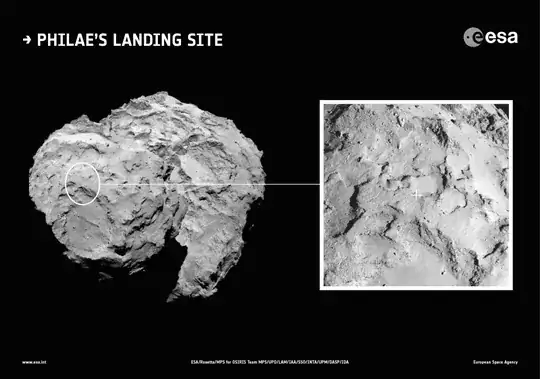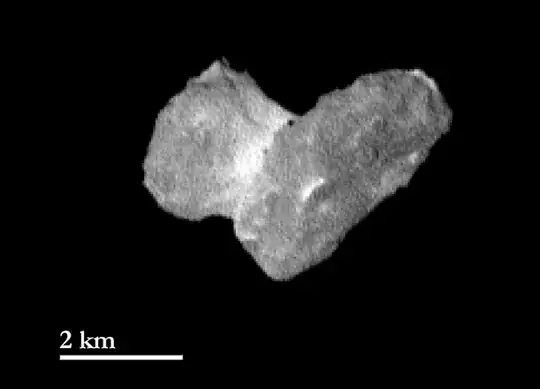I'm trying to simulate the Philae landing by writing a program to compute the position of the lander vs time. According to various mission websites, the orbiter will match its orbit to the rotation of the comet, then move toward the comet to impart an initial velocity on the lander as it releases it. The lander will "free fall" toward the comet, landing approximately 7 hours later at a velocity no greater than 1.0 m/s.
My simulation will assume a straight-line trajectory from the orbiter to the comet.
I gathered some figures from mission websites:
Mass of comet (MC): 1.0 x 1013 kg (Wikipedia)
Mass of lander (ML): 100 kg (ESA)
Mean diameter of comet: 4 km (Wikipedia)
Initial velocity of lander (v0): 0.187 m/s (ESA Blog)
Height of release: 22.5 km (ESA Blog)
I can't use a constant gravitational acceleration because the gravitational pull will be increasing as the lander approaches the comet. So I (with the help of a physics prof.) derived the following formulas. Since the forces will be changing as the simulation progress, we used an iterative set of formulas in which the next set of values is computed from the previous set. In the following, $n$ is the current iteration and $n-1$ is the previous iteration.
$$ a_n = \frac{GM_c}{r^2} $$
$$ v_n = v_{n-1} + a_{n-1}\Delta t $$
$$ r_n = r_{n-1} - v_{n-1} \Delta t - \tfrac{1}{2} a_{n-1} \Delta t^2 $$
(The signs are chosen so that $a_n$, $v_n$ and $r_n$ are non-negative quantities.) We can set up a table of computed values, using $\Delta t = 60$ seconds:
| n | a | v | r |
----------------------------------------
| 0 | 1.1112E-6 | 0.187 | 24500.0 |
| 1 | 1.1122E-6 | 0.18706 | 24488.78 |
| 2 | 1.1132E-6 | 0.18713 | 24477.55 |
etc...
As you can see, the velocity and acceleration are both increasing and the radius (height) is decreasing. That's good.
I stop the simulation when $r$ drops below 2000 meters (the mean radius of the comet).
The problem is the simulation predicts the descent will take ~21 hours. The real descent will take ~7 hours. I'm off by a factor of 3.
I tried changing $\Delta t$ to 1 second, but the numbers don't change much.
Will these formulas work for the simulation? And am I using the correct initial values?

